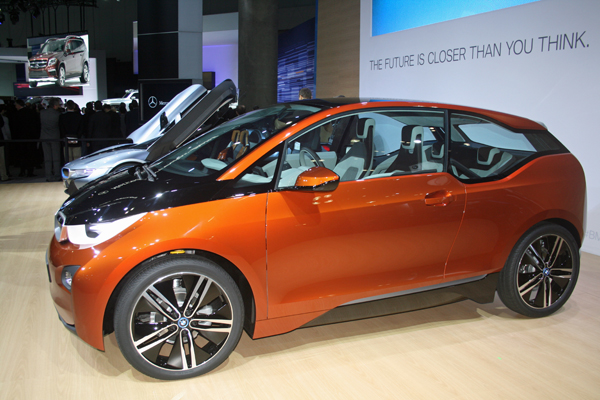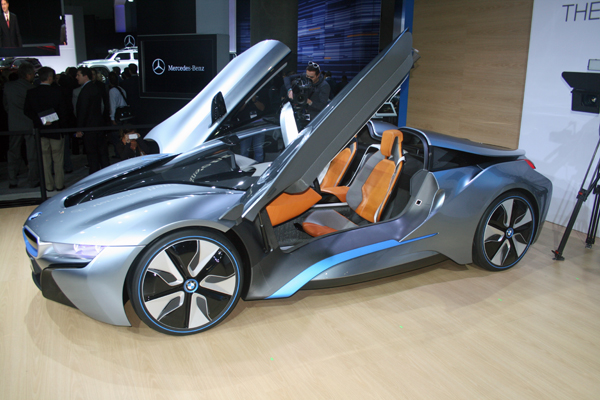Electrified vehicles are more and more on the minds of automakers, particularly in Germany, as we observed from the recent Frankfurt Auto Show a slew of announcements on concept and production models. Now we see a little more as well of the thoughts of automotive leadership around this push, which thus far has amounted in this nation alone to 12 billion euro worth of investment in alternative drivetrain development. To gain more insight, we turn to a recent news release from the German automotive industry highlighting comments on this development market sector.
“Electric driving is no longer a vision, but reality. The automotive future can already be experienced. That is very clear at this IAA,” said Matthias Wissmann, President of the German Association of the Automotive Industry (VDA). He was speaking to around 400 international guests at the “Electric Mobility Congress” held at the 65th IAA Cars in Frankfurt. The congress was organised by the VDA in co-operation with other industrial associations (BDI, BDEW, Bitkom, VCI, VDMA and ZVEI). “By the end of 2014, 16 electrified series models ‘Made in Germany’ will be on sale, running on pure battery-electric power or a combination of an electric motor and an internal combustion engine (plug-in hybrid or range extender). The models range from fully electric small cars to medium segment long-distance vehicles and light commercial vehicles, and all the way to sports cars charged with emotion.”
Wissmann added that the German automotive industry was investing 12 billion euro in the development of alternative drive trains over the next three to four years alone.”Here at the IAA you can see that our companies are tackling this technological turning point with enthusiasm and determinedly putting in advance work. The entire German industry is making good progress in exploiting the opportunities provided by electric mobility to benefit Germany as an industrial location,” Wissmann stressed. The rising number of vehicle models was giving electric mobility an extra boost. In the year 2014, he said, tens of thousands of vehicles could be sold – and by the middle of the decade the number might be in six figures.
“We are convinced that first of all we have to reach the users of company cars. This is an effective route for the market launch, given that as a rule company cars remain with their first owner only for quite a short time and then appear on the used car market, where they expand the fleet. Electric vehicles are becoming a lot more attractive to commercial customers owing to their lower running costs compared with conventional vehicles. We therefore explicitly welcome the compensation on electric vehicles passed by the German Government. Furthermore, we see major leverage in the form of special depreciations for commercially used electric vehicles.”
Turning to the planned European CO2 Regulation currently being negotiated in Brussels, the VDA president said: “Innovations are the key to sustainable forms for the mobility of tomorrow. One option for promoting alternative drive trains is super credits.” This means that especially efficient vehicles that are already included in the valid regulation count several times over, to reward manufacturers who bring very low-emissions vehicles onto the market especially early. “However, the European Commission’s present proposal for super credits will wipe out the incentives. For super credits to be effective, they must have a bigger multiplying factor,” Wissmann demanded.

In his speech the European Commissioner for energy, Günther Oettinger, stated that electric mobility was a major focus within European energy policy. “Since mobility does not stop at the borders of the Member States, it would be smart to ensure common standards in this field,” Oettinger said. Furthermore, politicians were faced with the task of encouraging the establishment of a charging infrastructure that provided total coverage. “Here we should keep an open mind and see which direction developments take over the coming three to five years, and how standardisation might look then at European level.” Oettinger also went into the subject of the planned CO2 limit values for passenger cars in the year 2020. “The 95 gram target is very ambitious; industrial policy and action on climate must be harmonised,” the commissioner stated. He was therefore appealing for “pragmatic, flexible application, with step-by-step introduction and an intelligent form for super credits.”
Prof. Thomas Weber, member of the Board of Management at Daimler AG responsible for Group Research & Mercedes Benz Cars Development, gave a lecture entitled “Back to the future: electric mobility between hype and reality.” Weber stressed: “With our vision of zero-emissions driving we arrived in the everyday world of automobiles a long time ago. This is because our product portfolio already includes nine electrically powered vehicles. And we are delighted that other automotive manufacturers are also triggering new impulses on the market for electric mobility with their new models.”
Barb Samardzich, Vice President, Product Development at Ford of Europe, chose “Electrified drive trains – an important component in future mobility” as the topic for her talk.”Electrified drive trains are an important component of future mobility solutions,” Samardzich explained. “The long-term development of a permanently successful market requires co-operation between all the stakeholders – interest groups just as much as the lawmakers, energy providers and the electric and automotive industries – to reduce the costs of building the vehicles and of the infrastructure.”
Dr Urban Keussen, SVP Technology & Innovation at E.ON AG, explained the “Systemic Approach” of electric mobility in the field of energy. “The IAA 2013 shows once again that electric mobility is picking up speed; it is moving slowly but surely out of the phase of demonstration projects and into everyday use,” Dr Keussen said. “The creation of the necessary charging infrastructure is running parallel with this development. Today we know that the great majority of users charge their electric cars on private premises – at home, at their workplace, or while out shopping or at a restaurant. Public charging stations, on the other hand, will continue to play only a complementary role. For this reason we as energy companies are primarily backing tailored charging solutions that we will realise jointly with customers and partners.”
Dr Ingo Ramesohl of Robert Bosch GmbH described “Changes in the value-added chain at Bosch.” He explained that “we see our strengths in electronics and sensor systems offering good prospects for being a major force in shaping the future of the car – in the electrification of driving, plus its automation and connectivity.”
Prof. Werner Tillmetz, Member of the Board at the Centre for Solar Energy and Hydrogen Research Baden-Württemberg (ZSW) and head of the Electrochemical Energy Technologies Division, went into detail in his lecture about batteries as a “key technology for electric mobility.” Prof. Tillmetz emphasised, “Electric vehicles are rapidly gaining in importance around the world. It will be crucial to Germany as an automotive country to apply wide-ranging competencies in the important battery technology to ensure competitiveness and value-added at home.”
Ralf Schmid, Vice President R&D, Business Unit Hybrid Electric Vehicle at Continental AG, explained a system supplier’s view of electric mobility in his speech. “Customised electrification uses 48 V components to plug the gap between simple 12 V stop-start systems and high voltage hybridisations. The ‘48 Volt Eco Drive’ is easy to install and already offers a large number of functions and consumption advantages that until now have been confined to mild hybrids with their higher voltage systems. The concept is arousing broad interest in the industry, and the first customer orders indicate that production will start in 2016.”
Dr Thomas Schlick, Partner at Roland Berger Strategy Consultants, presented “An international comparison of electric mobility.” “Following overblown expectations regarding electric mobility, more and more electric vehicles are now being produced in series,” Schlick stated. “When it comes to the technological development of electric mobility, in a global comparison Germany is running equal with the most important industrial nations. Yet now the next step should follow: electric cars should be positioned on the market at an attractive price for the customers. Alongside general customer acceptance of e-vehicles, however, the most important thing is to create a charging infrastructure offering total coverage. And that requires a complete concept from industry and politicians.”

The final item on the congress programme was the keynote speeches describing “Examples of products under market preparation” by Dr Peter Gebhard, Audi AG; Markus Krieg, BMW AG; Dr Christine Haller, Daimler AG; Christof Kellerwessel, Ford-Werke GmbH; Dr Christian Kunstmann, Adam Opel AG; and Thomas Lieber, Volkswagen AG – followed by a panel discussion.
Dr Peter Gebhard of Audi AG said, “The A3 e-tron is, like every Audi, suitable for everyday use in all respects, whether you want to go shopping locally with zero emissions, or drive to work, or take a snap decision to take your family on a longer weekend trip – the A3 e-tron offers you all of this without any problem. And its CO2 output is only 35 g under the ECE standard.”
Markus Krieg of BMW AG explained that, “For most people electric mobility is something completely new and therefore generates a lot of questions. These questions have to be addressed to win customers over to electric mobility. Therefore, under the umbrella of 360°ELECTRIC, BMW i is uniting a large number of innovative products and services that make electric driving a comfortable experience and absolutely suitable for an everyday pleasure: from simple charging at home to the convenience of a continually expanding public charging infrastructure, and all the way to connected navigation and the possibility of using conventional vehicles for holiday trips via BMW Add-on Mobility. Moreover, BMW i supports the use of electricity from renewable sources, and in co-operation with selected partners it makes available a choice of different green electricity products.”
Dr Christine Haller from Daimler AG stated, “Electric mobility is more than just driving a car. Only those who also offer the customers a convincing service package will be successful on the market in the long run. We therefore anchored this factor into our product planning very early on.”
Dr Christian Kunstmann from Adam Opel AG said, “Ultimately it is the customer who determines the success of electric mobility.”
Thomas Lieber of Volkswagen AG said, “At the IAA Volkswagen is adding the brand’s first electric vehicle to its model range: the new e-up! Volkswagen comes up trumps twice over in electric mobility, as the four-seater city car will be followed in 2014 by another zero emissions Volkswagen: the company is electrifying the most successful European car of all time – the Golf. So the bestseller that has rolled off the production lines more than 30 million times is developing into the e-Golf. Thanks to innovative detailed solutions, both e-vehicles are especially economical with the energy they use.”